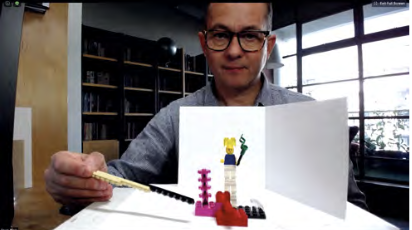The improved Remote Daily Scrum
 Koen Wellens
Koen Wellens
Every software development team I’ve worked in has used Scrum. While there’s been a lot of Scrumbuts with which I don’t always agree, all the teams I worked with had the Daily Scrum. This 15-minute meeting allows the team to change their gameplan if certain problems have shown up in the previous 24 hours. Taken from the official Scrum Guide, the official definition of a Daily Scrum starts with this:
“The purpose of the Daily Scrum is to inspect progress toward the Sprint Goal and adapt the Sprint Backlog as necessary, adjusting the upcoming planned work.”
It’s a planning adjustment tool. The meeting is held every day at the same time and place. Except this changed in the Covid pandemic. Instead of having our Daily Scrum at our regular workplace, we had to do it from home and online.
This has caused problems. Not everyone is immediately able to adjust to the remote environment while keeping their meetings short and to the point. I’ve seen a lot of post-Covid remote Daily Scrums run overtime, lose focus, and just stop working altogether.
It’s easy for an Agile Coach or a Scrum Master to call this out. It can be hard to undo the damage that has been done. Team members might lose faith in the Daily Scrum. I’ve seen and heard the question “Can’t we just use chat for this” too many times over the last 3 years. We tend to forget an additional benefit to having your remote Daily Scrums: you stay connected to the team.
Enter LEGO® Serious Play®
So how can we spice up a 15-minute meeting so that the participants are engaged? Enter LEGO® Serious Play®. This playful method has multiple aspects where one allows participants of a 15-minute meeting to come to a common understanding of a certain topic.
LEGO® Serious Play® meetings have multiple benefits. Participants are engaged and learning new things. Both visually as well as respectfully, they are communicating with each other.
What’s interesting for remote Daily Scrums is called Build Level 1. Good Build Level 1 sessions have the following structure:
There is a clear objective.
There is a good build question that allows participants to build.
There are reflection questions to see if we've achieved said objective.
Preparing your Remote Daily Scrum
First things first: make sure everyone who participates in your Daily Scrum has access to LEGO®. If they don’t, send them a bag of LEGO® bricks. Explain the setup to all team members and maybe call them one by one to show how a good BL1 setup can be achieved. You want to be able to see someone through their webcam, but also their LEGO® construction. Below is a picture of Sean Blair from SeriousWork, taken from the book "How to facilitate the LEGO® Serious Play® method ONLINE" to demonstrate.

The next thing you need is to come up with good objectives for your Daily Scrum. This part is easy because we have that in the official scrum guide! A good objective for your Daily Scrum could be “To inspect progress toward the Sprint Goal”. Or maybe “To adapt the Sprint Backlog as necessary” is an objective that suits your team better. Another example is “To adjust the upcoming planned work”.
With this objective in mind, we can work on the build question. This is the question we’re going to ask everyone at the beginning of our remote Daily Scrum. These build questions require participants to build a model for approximately 3 minutes on their own. Here are some examples:
Build a model to show how our product met the Sprint Goal by the end of the sprint.
Build a model to show how our product looks like by the end of next sprint.
Given the build questions and the objective, we need to come up with reflection questions to help participants to think about all the models that were built. This helps them get a clear, visual understanding of what's going on in the heads of others. Some example reflection questions in a Daily Scrum might be:
What ideas stand out?
What idea is worth thinking about?
What ideas forecast problems that might hold us from reaching the Sprint Goal?
How different are our models from where we are at the moment?
What concrete action should happen next?
Don’t give too many reflection questions. Just one will suffice for your remote Daily Scrum. Picking a reflection question is easy: the answers should align with the objective you set for your Daily Scrum.
Holding your Remote Daily Scrum with LSP
Start your Daily Scrum by showing one slide. It should contain the objective you've chosen for your team on that day. Read it out loud in a clear and calm voice to make sure everyone understands. Next, read the build question and tell them they have 3 minutes to make their model individually. You can add music during the build time.
When the 3 minutes are halfway through, we repeat the build question so that people stay focused. After building, we allow all participants to share how their model answers the build question. It’s just show-and-tell with a little room for questions. When all team members have explained their model, we need to round up with a reflection question.
Was your object to inspect progress towards the Sprint Goal? It might be enough to see what ideas stand out after showing what the product looks like at the end of the sprint. If your objective was “To adjust the upcoming planned work”, you might want to end with a question about what the team will do next.
The picture was taken by Unsplash user FORTYTWO.
What if your team doesn't want to play?
If your team is new to LSP and decides that it can't be used in their Daily Scrum because of its playfulness, try it out in a different meeting. Give your participants space and time to play around and practice technical skills as well as metaphorical skills.
Allow your participants to learn new techniques by asking the build question: "Build a model that has at least one connection that is new to you". In the end, reflect by asking which techniques stood out. This allows your participants to play with LEGO® and get used to the idea of build questions and reflection questions.
You can also play the 1 brick metaphor game, as designed by SeriousWork. Holding one brick up, ask everyone in turn what the brick stands for. This can be anything, ranging from a rock to global climate change. There's no right or wrong answer. The goal of the exercise is to let everyone create a metaphor for the brick and then understand that they don't need to build spaceships to talk about a spaceship. They can use a few bricks and metaphors to reach the same result.
Conclusion
If you're working in a remote Scrum team and feel like you're Daily Scrums aren't as effective as they used to be, think about a new format. In this article, I explained how you can use LEGO® Serious Play® to keep your team members engaged, on-topic and to the point.
After preparing a build question and a reflection question, we allow the team to achieve the goal of the Daily Scrum: to inspect progress towards the Sprint Goal, to adapt the Sprint Backlog as necessary and to adjust the upcoming planned work. They do this by building a LEGO® model and showcasing it to the team. This timeboxed activity allows a shared visual understanding of the current situation of the team and where it stands concerning the Sprint Goal.
Subscribe to my newsletter
Read articles from Koen Wellens directly inside your inbox. Subscribe to the newsletter, and don't miss out.
Written by

Koen Wellens
Koen Wellens
I am a freelance agile software engineer from Belgium.
